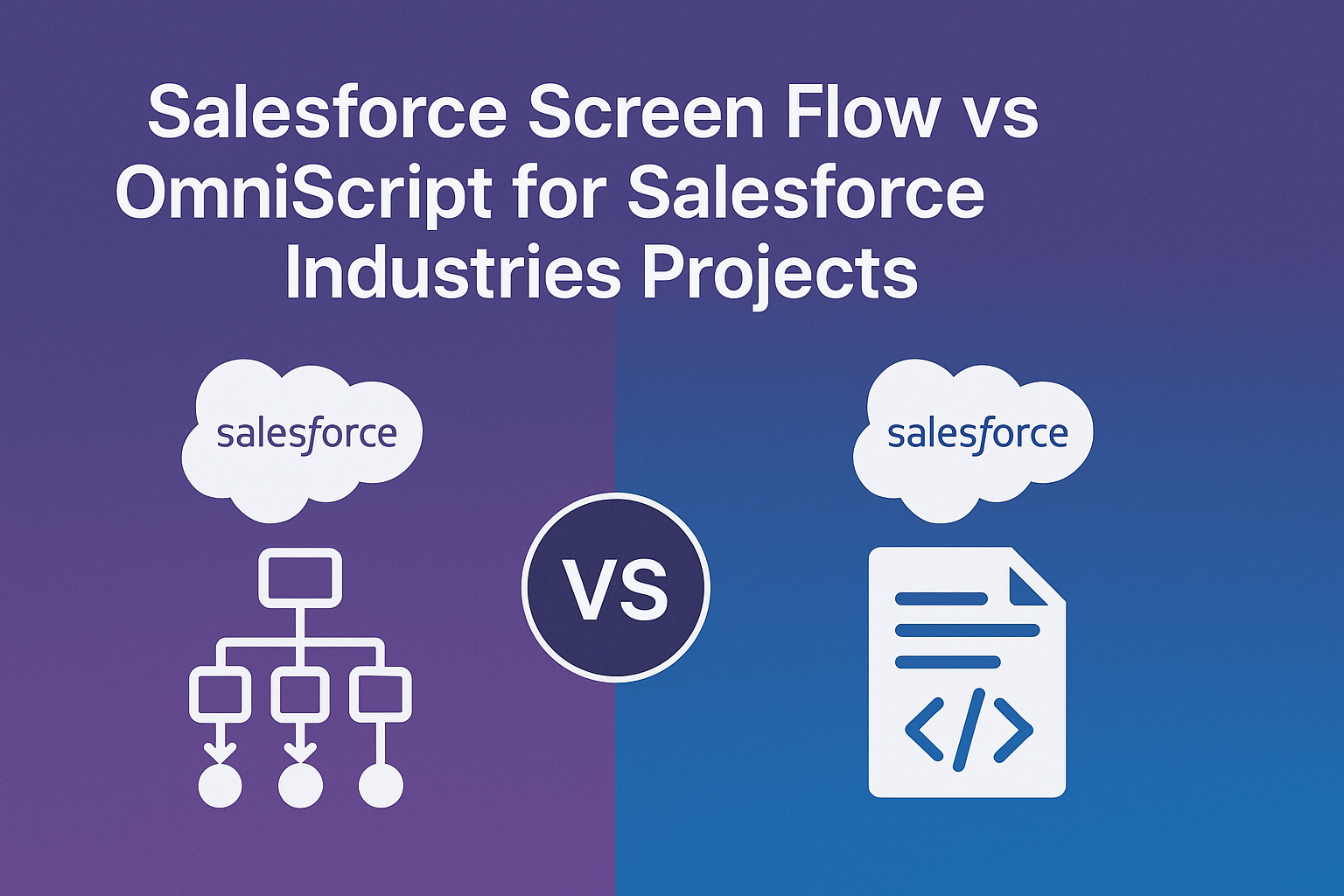Salesforce Screen Flow vs OmniScript for Salesforce Industries Projects
 Sathish Kumar Ramesh
Sathish Kumar Ramesh
Screen Flow
Overview
Screen Flow is a Salesforce-native tool built on the Lightning Platform, ideal for building user interfaces and automating processes in Salesforce. It is simple to use and integrates seamlessly with standard Salesforce objects.
Key Features
• Drag-and-drop interface: Easy to design screens and logic.
• Native integration: Works seamlessly with standard Salesforce objects, fields, and components.
• Lightning-ready: Optimized for Lightning Experience and mobile-friendly UIs.
• Debugging: Easier to debug and test within Salesforce.
When to Use Screen Flow?
• Simple processes: For example, a single-screen form or quick data entry.
• Salesforce-native requirements: When working with standard Salesforce objects (e.g., Accounts, Contacts, Opportunities).
• Quick implementation: When you need to build something fast without a steep learning curve.
• No additional licensing: Avoid extra costs since it's part of Salesforce core.
Limitations
• Less flexibility: Not ideal for highly complex, multi-step processes.
• Limited industry-specific features: Does not have pre-built templates for industries like telecom, insurance, or healthcare.
• Reusability: Harder to reuse across different projects or orgs.
OmniScript
Overview
OmniScript is part of Salesforce Industries (Vlocity) and is designed for industry-specific use cases. It is more advanced, enabling the creation of complex, multi-step processes with reusable components tailored for industries like telecom, insurance, and healthcare.
Key Features
• Multi-step processes: Ideal for workflows with multiple steps (e.g., customer onboarding, claims processing).
• Industry templates: Comes with pre-built templates for telecom, insurance, healthcare, and other industries.
• Reusable components: Create reusable OmniScripts to embed in different processes.
• Flexibility: Highly customizable for complex business logic and dynamic UIs.
• DataRaptors and Integration Procedures: Works seamlessly with Vlocity’s DataRaptors (for data transformation) and Integration Procedures (for external system integrations).
When to Use OmniScript?
• Complex processes: For example, a customer onboarding process with multiple steps and conditional logic.
• Industry-specific requirements: When you need pre-built templates or components tailored for specific industries (e.g., telecom, insurance).
• Reusability: When you need to reuse the same process across multiple projects or orgs.
• Large-scale implementations: Ideal for enterprise-level projects with complex requirements.
Limitations
• Steeper learning curve: Requires knowledge of Vlocity/OmniStudio tools and concepts.
• Licensing costs: Additional licensing may be required for Salesforce Industries.
• Debugging: Harder to debug compared to Screen Flow, especially for complex logic.
Key Differences
| Aspect | Screen Flow | OmniScript |
| Complexity | Best for simple, single-screen processes | Best for complex, multi-step processes |
| Industry-Specific | Not industry-specific | Built for industries (e.g., telecom, insurance) |
| Reusability | Limited reusability | Highly reusable across projects |
| Learning Curve | Easy to learn | Steeper learning curve |
| Licensing | Included in Salesforce core licenses | Requires additional Salesforce Industries licenses |
| Integration | Works with standard Salesforce features | Works with DataRaptors, Integration Procedures, etc. |
Example Scenarios
Screen Flow
• A simple form to update a Contact’s details.
• A quick approval process.
OmniScript
• A customer onboarding process with multiple steps, conditional logic, and integration with external systems.
Conclusion
In conclusion, if you're new to Salesforce Industries or have a straightforward requirement, Screen Flow is the best place to start. However, for complex, industry-specific projects that require greater flexibility and customization, OmniScript is the better choice. Selecting the right tool depends on the complexity of your use case and the level of control you need over the user experience.
Subscribe to my newsletter
Read articles from Sathish Kumar Ramesh directly inside your inbox. Subscribe to the newsletter, and don't miss out.
Written by
